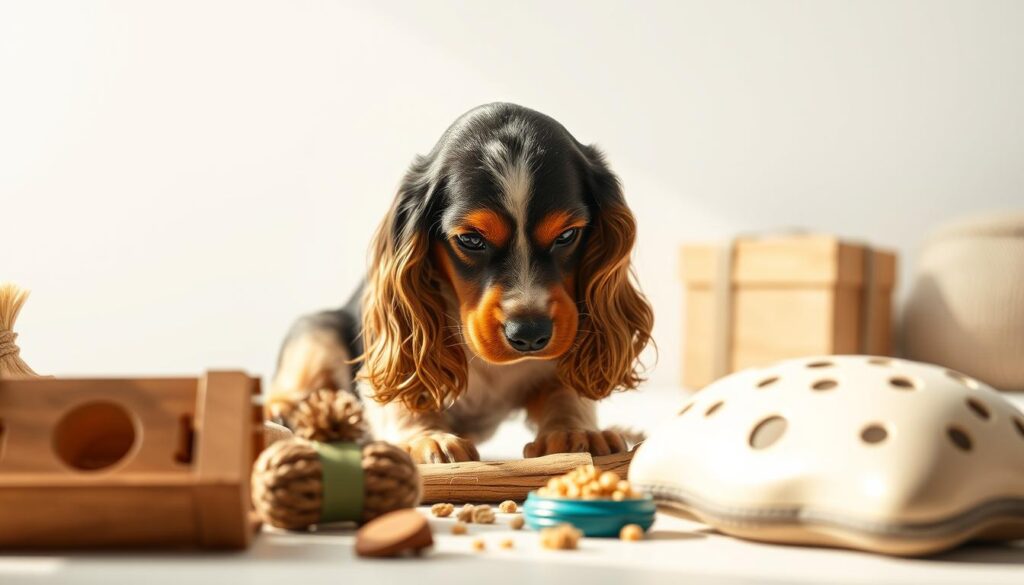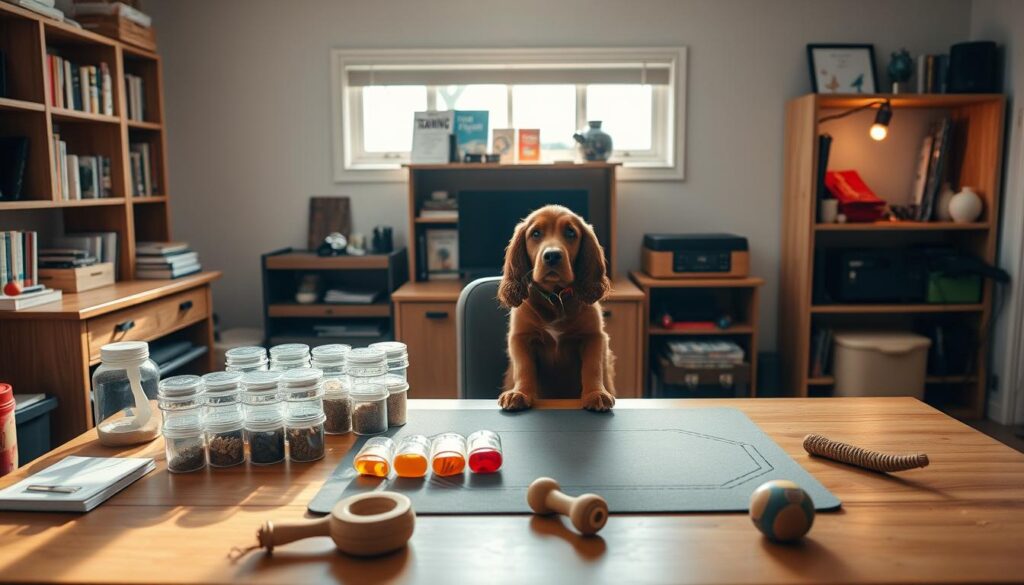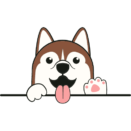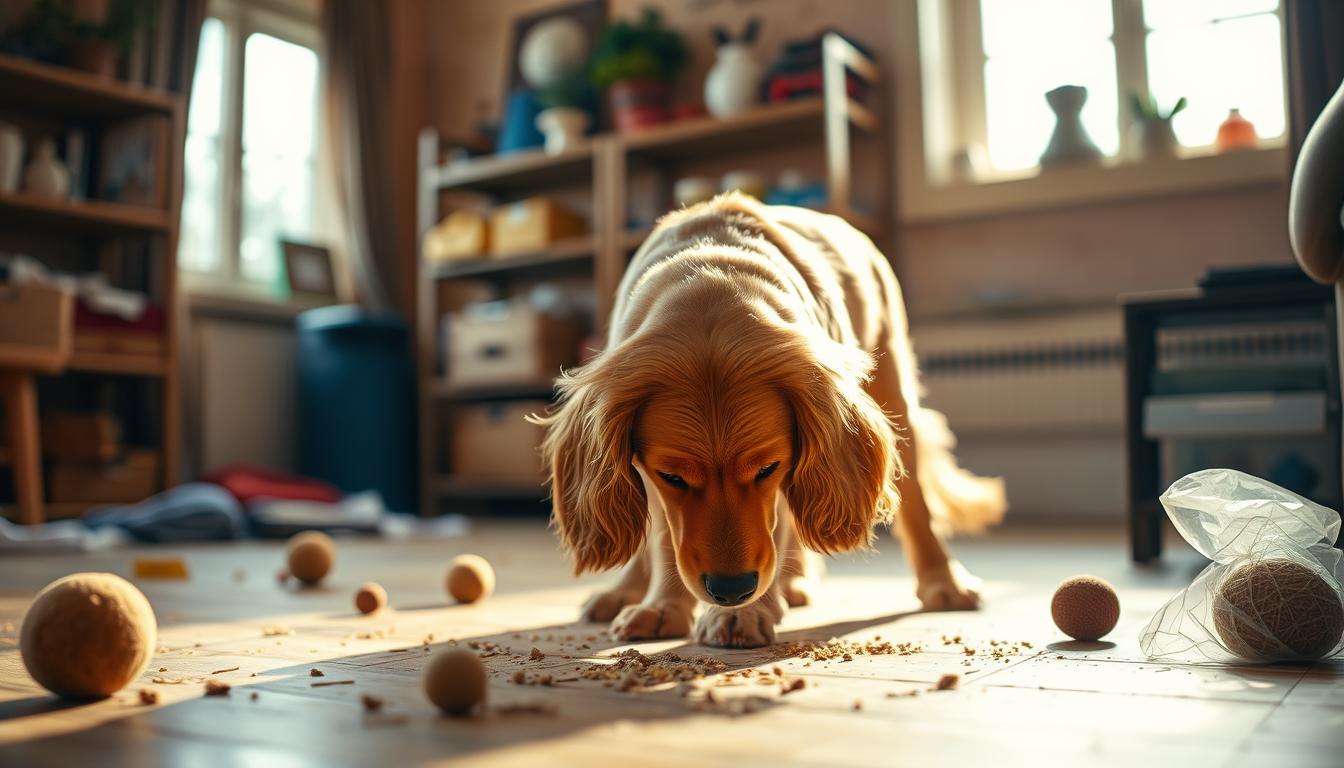Does your four-legged companion light up when exploring new smells? Scent-based games tap into your pet’s natural instincts, offering mental enrichment that’s as rewarding as a walk in the bush. Best of all, these activities require little more than everyday items and a sprinkle of creativity.
This breed’s hunting heritage makes them exceptionally talented at sniffing out challenges. Whether you’re in a suburban backyard or a coastal park, scent games adapt to any environment. They’re perfect for pups learning focus or older mates needing gentle stimulation.
What makes scentwork a great way to bond? It celebrates how dogs experience life – through their remarkable noses. While we might miss subtle odours, our pets detect entire stories in a single whiff. Channeling this ability builds confidence and strengthens your connection.
Key Takeaways
- Natural nose-driven games suit pets from playful pups to senior companions
- Requires minimal gear – start with household items
- Boosts mental fitness while reducing boredom-related mischief
- Strengthens trust between you and your furry mate
- Local clubs offer structured training and social opportunities
Australian owners are discovering how scent challenges turn routine days into adventures. Ready to unlock your mate’s hidden potential? Let’s explore practical techniques that make every sniff count.
Introduction to Cocker Spaniel Scent Work
Imagine turning your backyard into a detective playground for your pooch. This is the magic of scent-based activities – structured games that let pets follow their noses to solve puzzles. Unlike traditional obedience training, these exercises celebrate a dog’s natural talents while building teamwork between owner and companion.
What Is Scent Work?
Often called nosework, this sport transforms everyday sniffing into goal-oriented challenges. Pets learn to locate specific odours hidden in boxes, rooms, or outdoor spaces. It’s like hide-and-seek with purpose, where success earns tasty rewards or favourite toys.
Professional detection teams use similar methods, but home versions focus on fun over formality. Beginners might start with treats in muffin tins, while advanced pups search for essential oils. The key lies in letting the nose lead – not commands from humans.
Why It’s Perfect for This Breed
Bred to track gamebirds through dense scrub, these energetic companions thrive when using their exceptional sniffing skills. Their history as hunting partners means they’re wired to search tirelessly and think independently. Food-driven personalities help them master new scent puzzles quickly.
This low-impact activity suits all ages – from hyperactive youngsters to older mates with stiff joints. Aussie owners often report calmer behaviour after mental workouts that satisfy natural instincts better than fetch ever could.
Benefits and Behavioural Insights for Australian Dog Owners
Ever noticed how a simple sniff transforms your pet’s walk into an adventure? Scent-based activities offer more than entertainment – they create pathways to better behaviour and stronger relationships. These exercises meet pets at their level, celebrating instincts while addressing common challenges.

Mental Stimulation and Bonding
Twenty minutes of sniffing tires pups more than an hour-long walk. This breed’s sharp mind thrives on problem-solving, turning hidden treats into rewarding puzzles. Owners like Jamie found scentwork transformed walks with his reactive German Shepherd: “Frankie’s focus improved dramatically once he had a ‘job’ to do.”
Teamwork builds trust. As you guide searches with hand signals or encouragement, your pet learns to read subtle cues. This silent communication strengthens bonds far beyond basic obedience training.
Managing Reactive and Senior Dogs
Overstimulated pets often calm when given purposeful tasks. Sniffing activates the brain’s relaxation response, making it ideal for animals stressed by crowds or other dogs. Gemma’s spaniel stayed content during crate rest after surgery through daily scent challenges.
Older companions benefit equally. Low-impact nose games keep minds sharp without straining ageing joints. During heatwaves or smoky days, indoor scent trails maintain routine while protecting delicate paws.
Whether curbing leash-pulling or supporting recovery, these activities adapt to life’s changes. As one trainer notes: “A engaged nose means a content heart – it’s that simple.”
Setting Up Your Scent Work Environment and Kit
What if your laundry basket became a treasure trove for curious noses? Building a sniff-friendly space starts with everyday items you already own. The key lies in choosing objects that spark your companion’s natural curiosity while keeping sessions safe and rewarding.

DIY Scent Work Kit: Tennis Balls, Toys and Treats
Tennis balls shine as multi-purpose tools – stuff them with smelly treats or use them as hiding spots. Combine three different-sized balls to create difficulty levels. Pair these with empty toilet rolls or egg cartons for quick indoor setups.
Food-driven pets thrive when hunting cheese cubes or dried liver in muffin tins. For play-focused mates, wrap favourite toys in tea towels and hide them under chairs. Rotate items weekly to maintain excitement. As trainer Jamie notes: “A bored dog quits searching – keep their kit fresh!”
Creating a Safe Training Space at Home
Start in quiet areas like spare rooms or enclosed patios. Remove choking hazards and secure loose wires before sessions. Ventilation matters when using strong-smelling rewards – open windows in stuffy spaces.
Expand to your garden once basics are mastered. Use pot plants or outdoor furniture as hiding spots. Always supervise water play if using damp treats. Remember: short, successful searches build confidence better than marathon sessions.
With just a lead and a toy they adore, you’re ready to begin. The real magic happens when ordinary spaces become sniffing playgrounds – no fancy gear required.
Step-by-Step Guide: How to Begin cocker spaniel scent work
Ready to turn your daily walks into sniffing adventures? Starting scent-based activities requires just three things: a smelly reward, a quiet space, and patience. Let’s break down the process into bite-sized steps any owner can master.
Creating a Basic Scent Trail
Begin with high-value treats like diced chicken or cheese. Drag the food along the ground in straight lines, creating visible marks. Hide the reward under a flowerpot or behind a chair – keep initial trails short (2-3 metres).
Lead your companion to the starting point using a harness. Let them sniff the treat first to create a clear scent connection. As their nose drops to follow the trail, stay silent – this is their puzzle to solve.
Building Confidence Through Success
Start with obvious trails where the reward stays partially visible. Celebrate every find with enthusiastic praise and immediate access to the treat. Hand-feeding the reward reinforces that sniffing leads directly to good things.
Gradually increase difficulty by:
- Making trails longer (up to 5 metres)
- Hiding rewards completely
- Adding gentle curves in the path
For play-driven mates, swap treats for furry toys dragged through grass. Remember: three successful short sessions beat one frustrating marathon. As Brisbane trainer Mia advises: “Let their nose write the story – your job is just to turn the page.”
Engaging Scent Games and Enrichment Activities
Turn snack time into a brain-boosting challenge with simple household items. These three sniff-tastic activities sharpen natural abilities while keeping tails wagging. Best part? They’re budget-friendly and work in any space – from balconies to bushland clearings.
Muffin Tin Puzzle for Beginners
Transform a 12-hole baking tray into a nose-powered puzzle. Place smelly rewards under three random cups, then fill remaining spots with empty balls. Watch paws and snouts collaborate to uncover hidden treasures. Rotate treat locations each session to prevent pattern memorisation.
The Magic Trick Cup Game
Upcycle plastic containers or terracotta pots for this classic hide-and-seek twist. Start by sliding a treat under one cup while your mate watches, then shuffle slowly. Gradually increase difficulty by hiding snacks mid-shuffle or adding extra containers. Celebrate wins with enthusiastic praise!
Box Search to Stimulate Their Nose
Repurpose delivery boxes by layering crumpled paper and kibble. Begin with partially exposed treats, then progress to fully concealed rewards. For advanced players, introduce multiple boxes with varying smells. This game builds persistence – perfect for energetic mates needing focused play.



